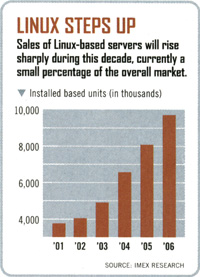By integrating its legacy applications with the company's Web site,
National Gypsum was able to avoid having to buy new computers. "It
actually takes fewer people to manage the mainframe environment,"
says Peter McCaffrey, director of product marketing for the eServer
zSeries mainframe business at IBM.
In keeping with the craze to save via centralization, some companies
have been able to get rid of a dozen, or 50, or even 100 smaller
servers by rehosting all their systems on a mainframe.
Similarly, Winnebago Industries Inc. continues to roll along with
its big box. "It's typical for companies to have unused capacity
on the mainframe," says Dave Ennen, technical support manager at
the Forest City, Iowa, maker of motor homes.
The company has been able to run a number of newer Web-type applications
on its IBM mainframe without having to add servers. "We've had mainframes
here since the early 1970s, and we still have a lot of homegrown
applications running on there that are critical to our business."
But for companies without an existing investment in mainframes,
the continuing surge of new server technologies tends to drive data-center
design. Many are investing in powerful new machines called "blade"
servers that essentially contain the guts of several PCs packed
onto a single card (as opposed to the more "traditional" — if
one can use that word in IT — rack-mounted server unit).

Ultimately, these machines offer the power of a supercomputer at
far less cost. "Blade servers use very standard elements to optimize
space, power, and cooling," says Anil Vasudeva, president and principal
analyst at Imex Research in San Jose, California. The modular servers'
flexibility means they can be configured into various telecom, networking,
or storage modules.
Blade servers can be harnessed to run any number of computing power-hungry
applications, including the high input/output requirements of online
transaction processing, decision-support systems with online analytical
processing, and on-demand video-streaming applications that require
high bandwidth. The impact of blade servers "will be truly profound,"
adds Vasudeva.
Blades are very much in keeping with the continuing commoditization
of the server market. Low-end machines have plunged in price to
the point where some observers refer to them as "disposable." Once
expensive and bulky, today's servers are priced so low that if one
fails, it's more economical to replace it than to fix it.

In some cases, the spares are already installed in standby mode,
waiting to be switched on. Dell Computer Co.'s lowest-priced server
sells for $349, including rebates. As recently as the late 1990s,
most servers typically were priced in the $12,000 to $100,000 range.
Regardless of what hardware one finds in the data center, the odds
are increasingly good that it will be running some version of Linux,
the legendarily "free" operating system that seems to win new converts
— even among vendors — every day. Linux isn't totally free,
of course; when companies adopt it, they typically spring for maintenance
and support services in order to have a vendor on call. But there
is no license charge, and for that reason alone most large companies
are giving Linux at least a chance.
Some have found that its associated costs — such as consultants
to install it and hiring new employees or training current staff
to use it — can swallow up much of the savings. "We asked ourselves
if this could possibly be a replacement strategy to drive our costs
down," says Ann Turnbull, first vice president and IS manager at
Mellon Financial Corp., in Pittsburgh. "We figured that the cost
of conversion would outweigh any savings over a two-to-three-year
period."
Despite a surfeit of media attention, Linux has not in fact taken
over the world; it accounts for just 5 percent of the server market.
But its momentum is unmistakable, and even Sun, which has long touted
its Solaris operating system, now offers Linux-based systems on
the low end.

